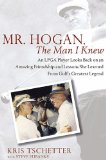Mr. Hogan, The Man I Knew
Among all of the biographies, sports stories and columns written about the famous Ben Hogan, one of his personality traits stood out.
This was not a man who could be easily approached.
The Scots, who thrilled to his 1953 British Open win at St. Andrews, reportedly called the thin, 5-foot-8-inch Texan the “wee ice mon.” It wasn’t because he preferred to drink his whiskey on the rocks.
Hogan’s legendary stoicism on the course allegedly carried through to his relations with other players, the gallery and the media.
As Curt Sampson noted in his fine biography of Hogan, the man had good reason to be taciturn at best and cold at worst. As a boy he’d watched his father commit suicide. That is bound to affect one’s psyche.
In retirement from professional golf, but while still the head of his Hogan Golf equipment company, Hogan was also famous for his daily routine, which included a light lunch at Shady Oaks Country Club in Fort Worth, followed by a little practice session on occasion.
In the mid-1980s, however, Hogan’s never-shifting schedule received a jolt, in the form of a vivacious young Texas Christian University golf team player named Kris Tschetter.
She’d finagled her way onto Shady Oaks as a convenient place to practice, spending hours on the range. Tschetter knew not to bother Hogan, but with the innocence of youth she didn’t realize how she might nonetheless affect the old man when he would see her practicing.
One thing led to another, and the South Dakota collegian’s natural charm eventually won over the aging golf star. The two soon began what became a noteworthy, unusual, and mutually rewarding friendship that lasted until Hogan’s eventual demise in 1997.
Tschetter eventually went on to a successful career as a popular player on the LPGA, urged on and occasionally quietly coached by Hogan.
She recently joined with Steve Eubanks to write a fond memoir of her time with the golfing legend, Mr. Hogan, The Man I Knew, (Gotham Books, $22.50 SRP).
The young woman dealt with Hogan in ways that must have appealed to him. Tschetter was respectful, but didn’t push him into giving her lessons. From all accounts, she never tried to trade on her relationship with Hogan, most likely another major plus. She loved to practice, as he did. She also apparently loved to tease him, something her more awestruck elders would never do. It turns out that Hogan loved to tease her right back.
Tschetter also didn’t know enough about Hogan’s actual competitive history to be overcome in his presence, certainly at the beginning of their time together. However, she also knew enough to appreciate the special relationship they had.
As one reads through the stories about practice sessions and their other times together, one likely explanation for the relationship begins to make a lot of sense. Hogan had no children of his own. Tschetter came into his life at a time when that fact may have hit him harder than before.
Here was this pretty young golfer, as ready to tease as to be teased, seemingly unfazed by his history, and whom Hogan could see had the talent to make it as a professional, with a little help. The old man gained a substitute granddaughter in the bargain, whom he clearly came to love in his own way.
Tschetter also gives her own explanation for why Hogan acted as distant and unapproachable to others as legend had it. People who become celebrities have to find their own way to be comfortable with themselves and the potentially incessant demands of their admirers. Hogan put up this shield, as she sees it, so as to draw a line between his public persona and his private life.
This is a charming little memoir.
Tschetter knows how lucky she was to have spent so much time with Hogan and does a nice job of conveying that fact to the readers. It is also readily apparent that Hogan enjoyed his own rewards for befriending this young, unassuming golfer.
Review Date: February 18, 2011


